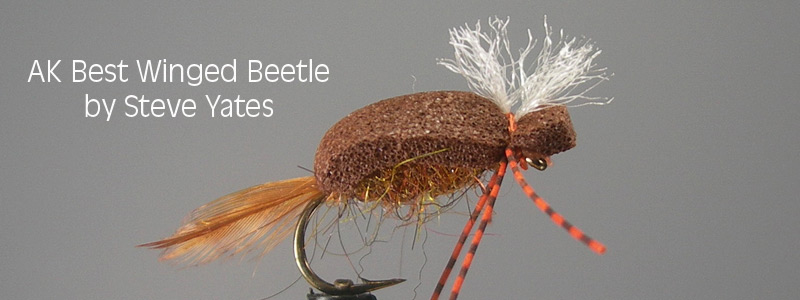Hook: TMC 100 sz 12
Thread: Rusty Brown
Tail: Pair of brown hen hackle tips
Body: SLF Golden Stone dubbing
Shellback: Dark Brown 2 mm closed cell foam
Legs: Trantu-Legs mini orange
Indicator: White High Vis
"In sheer weight of numbers of species, the beetles are the kings of the terrestrial domain. They are one the earliest of all terrestrials to appear in the spring and one of the last to disappear as the weather grows colder . . . They likewise hold a prominent position in the trout's menu, and it's a rare summer day when fish cannot be enticed to accept some form of artificial beetle." Harrison Steeves
Beetles are one of the most common life forms on earth. There are over 350,000 species, and new species are still being discovered. Aristotle named the order of insects they belong to Coleoptera, which in Greek means sheathed wing. Coleo = shield + ptera = wing. They represent 25% of all known life forms on earth. They are found from the polar regions to the tropics. Beetles have two sets of wings. A hard outer shell pair know as the elytra, and the second pair that they actually use for flying are know as the alae.
This is one of those flies that when you see it you think to yourself, “Why didn't I think of that?”. I had known for years that beetles and other terrestrials play an important part in the diet of trout. I can remember years ago catching fish that would be so full of beetles that they looked like they had been eating marbles. It was only when I prepared the fish for cooking and checked it's stomach contents that I discovered they had a stomach full of beetles Then after reading an article in Fly Rod and Reel by AK Best and seeing his winged beetle pattern that I started putting wings on some of my beetle patterns. His reasoning was that when a beetle hits the water his flight wings are splayed, and sure enough when I started taking notice, he was right.
Beetles are clumsy fliers and often hit the water with a splat. When they do you will often see the under wings splayed behind them and their legs kicking trying to escape from the stream. Forget fishing beetles with the same delicate presentation and long leaders as most of your other offerings. When I fish beetles or other terrestrials like hoppers for that matter, I try to make a cast that makes the fly land with a resounding splat. If you ever notice they don't just hit the water and lay there. They are kicking and struggling just like we would if we fell into a cold trout stream. Look for overhanging trees and stream side vegetation, and fish close to the bank. They will often take fish in slack water sections of a stream that you would have a difficult time getting trout to take a standard pattern in because of the drift and time the fish has to examine the fly. The splat from a beetle hitting the water is often like ringing the dinner bell for trout.


